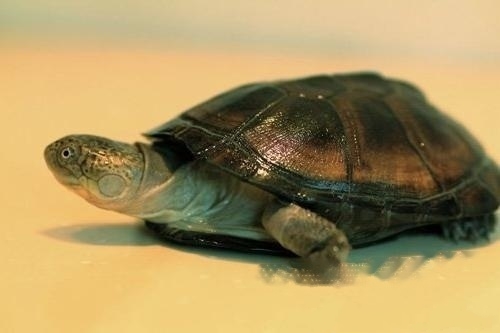TurtlesThere are sea turtles, freshwater turtles and land turtles. I read the news a long time ago, and a turtle owner said that he would release the turtles and put the turtles in the water. Ken replied that in the water, no matter how hard he tried, he couldn't get away. In fact, what I want to say is that not all turtles are water turtles, maybe they are tortoises, and they can't live in water at all, so when we buy turtles, we must learn to distinguish the habits of turtles!

I. According to the living environment
The types of turtles can be divided into terrestrial turtles and aquatic turtles according to their living environment. There are 5 types of turtles, semi-aquatic turtles, marine turtles, and bottom-dwelling turtles. The external morphology and structure of different types of turtles correspond to their living environments. For example, the toes and fingers of the aquatic turtles have abundant webs (like duck feet) to adapt to life in deep water; while the terrestrial turtles have thick and cylindrical limbs. Shaped to adapt to crawling on swamps and land; sea turtles living in the sea, all have paddle-like limbs, and all have a pair of salt glands to facilitate the secretion of excess salt in the body.
Second, according to food habits
According to the food habits of turtles, turtles can be divided into three types: animal turtles, plant turtles, and omnivorous turtles. The diet of aquatic turtles is generally omnivorous, such as turtles, yellow-throated terrapins, etc.; semi-aquatic turtles are mostly animal, such as flat-chested turtles, three-line box turtles, and golden-headed box turtles; and the yellow edge box Turtles and yellow-fronted box turtles are omnivorous. Most of the terrestrial tortoises are plants, such as Burmese tortoises, four-clawed tortoises, etc. Some turtles have strong ability to withstand hunger and thirst, but they are not easy to die if they do not eat for several years.
Three, according to appearance
1. Looking at the shape of the turtle, generally the thick ones are on land, and the thin ones are in the water.
2. Look at the turtle's nose. Generally, the aquiline nose is land, and other water.
3. Look at the turtle's tail. Generally, the tail of the tortoise is short and thick, and the tail is slender in the water.
4. Look at the front legs of the turtles. Generally, the forelimbs of tortoises are longer and stronger, while that of water turtles is the opposite.
5. Look at the hind legs of the tortoise. Generally, the hind legs of tortoises are like legs. Turtles maybe.
6. Looking at the claws, the claws of the water turtle are sharp and webbed, and the sharp barb-like shape is because the water turtle is generally carnivorous, which is convenient for preying and tearing meat, and the webbed is naturally for swimming.
7. Look at the eyes, the turtles have small and sharp pupils, and the tortoises basically cannot see the clear boundaries of the pupils, and they are completely black.
8. Look at the scales, tortoises have rough and thick scales, the reason is to keep water as much as possible and protect themselves from other land animals. The scales of the water turtle are delicate and smooth, in order to reduce the resistance when swimming.
9. Looking at the walking posture, a healthy tortoise will use its limbs to prop the whole body off the ground and walk calmly and steadily, so it is almost impossible to hear the sound of walking. It is more difficult for water turtles to walk on land, because their limbs are relatively short and their strength is not enough, and the joint bending method is different from that of tortoises, so when walking, they will keep making the sound of plastron hitting the ground, and their movements are clumsy.
Four. Common turtle species
1. Common aquatic turtle species: Brazilian turtle, map turtle, Snapping Turtle, Roof Turtle, Yellow-headed Turtle, Snake-necked Turtle, Pig-nosed Turtle, Big-Headed Turtle, Swamp Side-necked Turtle, Burmese Peacock Turtle, Tortoise, Spotted Turtle, Snail-eating turtles, European sea turtles, etc.
2. Common tortoise species: yellow-headed tortoise, Indian star tortoise, Burmese star tortoise, concave tortoise, four-toed tortoise, European tortoise, leopard tortoise, red-legged elephant Turtles, Hermann Tortoises, etc.
3. Common semi-aquatic turtle species: box turtle, golden box turtle, sun turtle, South American woodgrain turtle, yellow-rimmed turtle, black-breasted leaf turtle, yellow-fronted box turtle, money Turtle and so on.
V. Living habits of turtles
Turtles generally live in streams, rivers, lakes, swamps, and reservoirs in the natural environment, and sometimes go ashore Activity. Turtles feed on worms, snails, and small fish, as well as the stems and leaves of plants. Turtles are a kind of temperature-changing animals. In winter, or when the temperature is at a low temperature for a long time, the turtles will enter hibernation. Different types of turtles have different temperatures when they start hibernation, but they are usually between 10 and 10. 16°C. At this time, the turtle will shrink in the shell for a long time and is almost inactive. At the same time, its breathing frequency is reduced, its body temperature is lowered, the speed of blood circulation and metabolism is slowed down, and the nutrients consumed are relatively reduced. This state is similar to sleep, except that it is a deep sleep that lasts for several months, and even presents a slight paralysis.
![[Dog Training 5] The training method of pet dog dining etiquette](/static/img/12192/12192_1.jpg)




